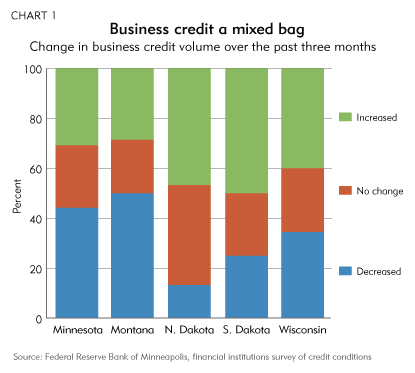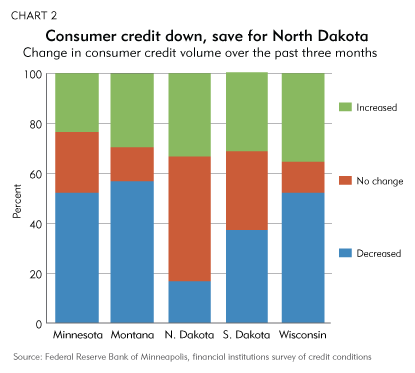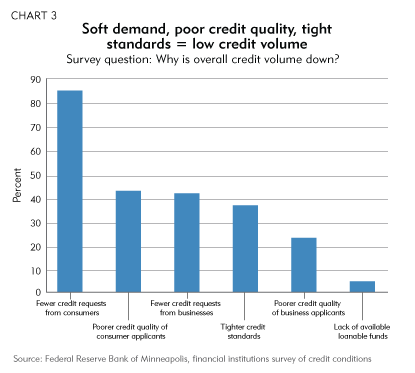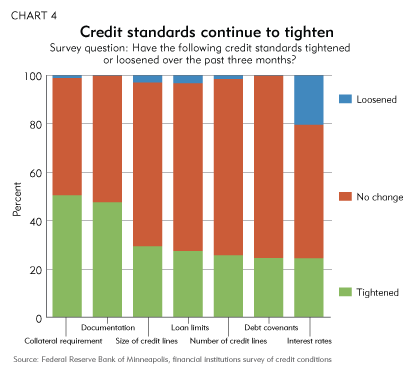
As the weather has warmed in the Ninth District, credit conditions have barely thawed, according to a recent poll of bank and credit union executives in district states by the Federal Reserve Bank of Minneapolis.
Financial institutions report that they have money to lend, thanks to growing deposits. However, there’s not a lot of demand for loans and other credit—a situation exacerbated by the fact that creditworthiness continues to sag among businesses and consumers. Financial institutions also continue to tighten their credit standards, with banks reporting a decline in small business lending, in part, due to concerns about the current and future regulatory environment.
Show me the money
There’s little doubt about the liquidity of financial institutions, as 70 percent reported that insured deposits had increased over the previous three months, while only 11 percent said they had declined.
But banks and credit unions reported that consumers and businesses are not asking to put much of that available credit to work (see Charts 1 and 2). Business borrowing appears to be mostly a wash, as fairly even numbers said the volume of credit to business was higher (35 percent) and lower (39 percent), and unchanged (26 percent) over the previous three months; responses from the Dakotas and Wisconsin were more upbeat than those from Minnesota and Montana. Consumer borrowing was markedly down; 50 percent of respondents said consumer borrowing had dropped, 29 percent saw an increase and the rest reported no change.
One Minnesota institution commented, “People are still saving more than borrowing.” A Wisconsin credit union added, “We have an enormous amount of liquidity to lend out to our members when they are confident enough in the economy to start borrowing again.” Finally, a Montana bank noted, “We have observed a trend that our best, most highly qualified borrowers are choosing to not borrow.”
Tighter credit standards and poorer credit quality also explain some of the lower demand for credit, according to those surveyed (see Chart 3).
Almost universally, credit standards have either tightened or remain unchanged from three months earlier (see Chart 4). Among the responses, not a single institution said it had loosened credit standards for business applicants, while just six of 307 institutions reported relaxing credit standards for consumers.
A Minnesota bank said it was “not seeing the opportunity to lend. When we do, we are much more stringent.”
Among various credit standards, collateral requirements and documentation were most frequently tightened (by almost half of respondents); about one quarter also tightened the size and number of credit lines. The only standard that saw even the slightest loosening was interest rates; the percentage of institutions that loosened interest rates was slightly less than the proportion that tightened them. In fact, significantly more Wisconsin institutions reported loosening (32 percent) interest rates compared with tightening (19 percent), and about half left interest rates unchanged.
Small biz on the sidelines
Credit quality among business and consumer applicants continued to deteriorate; only about 10 percent of respondents said that business or consumer credit scores had risen, while about half said they had declined for both groups. Said a South Dakota institution, “We have money to lend, but cannot always fund applicants due to inability to borrow. Their poor credit histories keep them from obtaining credit.”
The survey also asked specifically about credit conditions for small business. Results showed that demand for small business loans and lines of credit was mostly a wash across the district as a whole; those institutions seeing an increase were offset by those seeing a decline. However, responses were positive for every district state, save for Minnesota, where responses were much more pessimistic.
Those reporting a decline in credit to small business were also asked about the underlying source. The reasons cited for tight credit were all over the map, including a decline in demand and sagging creditworthiness among small businesses.
The most-cited reasons—though only by a small margin—were organizational uncertainty about future financial system reforms and regulatory restrictions on bank lending. A Minnesota institution stated flatly, “The regulatory environment has impacted our willingness to make loans.”
Not all respondents felt that way about the role of regulators, however. The percentage of respondents saying regulator influence was the most important factor for the decline in small business lending (27 percent) was slightly lower than those saying it had no role or influence (29 percent).
Methodology: This survey was conducted with the assistance of the 14 statewide bank and credit union associations in the six states wholly or partially located in the Ninth District. An e-mail alert was sent to about 2,800 bank and credit union contacts identified by these organizations. The e-mail informed members of the survey, its intent and where they could take the survey online. The survey was conducted from May 18 to May 25. A total of 308 responses were received. Eighty-five percent of respondents were from institutions with less than $250 million in assets, and 28 percent from those with less than $25 million.
Ron Wirtz is a Minneapolis Fed regional outreach director. Ron tracks current business conditions, with a focus on employment and wages, construction, real estate, consumer spending, and tourism. In this role, he networks with businesses in the Bank’s six-state region and gives frequent speeches on economic conditions. Follow him on Twitter @RonWirtz.









